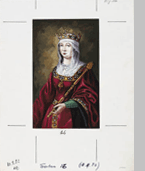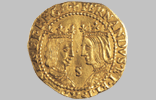V Centenary Isabella I de Castile
Biography
Isabella I of Castile, better known as Isabella the Catholic, was born in the town of Madrigal de las Altas Torres (Ávila) on April 22, 1451 in the palace of her father, John II of Castile, wedded to Isabella of Portugal.

With slight prospects at birth of ascending to the throne of Castile, the declaration of the illegitimacy of her niece, Joanna "la Beltraneja", made Isabella heiress to her stepbrother, Henry IV, though she had to win the civil war of 1475-1479 in order to occupy the throne. Her marriage to Ferdinand of Aragon brought the reestablishment of order and monarchical authority to the two Castiles. Spain became a strong, dynamic and expansive nation that was to witness important events such as the conquest of Granada and of the greater Canary Islands, and the discovery of the New World in 1492.
These historical milestones universalized the figure of the Queen. She died in Medina del Campo on November 26, 1504. To commemorate the fifth centenary of her death, the Spanish Royal Mint has approved, minted and circulated a series of proof quality collector coins, and a 12-Euro coin, dedicated to the commemoration of the event.
For further information visit the following links:
- Cáceres County Council: Fifth Centenary of Isabella the Catholic. Archives in honor of Isabella the Catholic on the Fourth centenary of her Death in the Revista de Extremadura (1904).
- Archbishopric of Valladolid: official page Fifth Centenary of the death of Queen Isabella the Catholic (link in spanish).
- Medina del Campo: celebration for the Fifth centenary of the death of Isabella the Catholic in Medina del Campo (link in spanish).
- Madrigal de las Altas Torres: Fifth Centenary of the death of Isabella the Catholic (link in spanish).
Reign of the Catholic Monarchs

The reign of the Catholic Monarchs spanned the years between 1474 and 1504. It marked the beginning of a period of great progress and prosperity that would put Spain at the head of Europe for over a century.
By the determination of the Catholic Monarchs, Spain played the leading role in events of such significance that they would mark the course of its history, such as the unification of the different kingdoms under the Crown, the definitive incorporation of the Canaries to the Castilian Crown, the annexation of the Nazarí Kingdom of Granada, or the landfall of Christopher Columbus in the New World.
The monetary system during the reign of the Catholic Monarchs

The monetary system was based on gold, silver and billon. The monetary diversity in existence in the different Spanish kingdoms on the accession of the Catholic Monarchs was influenced by two different areas: the Muslim and the European. The kingdoms that constituted the Crown of Aragon each issued their own coinage. During their reign Isabella and Ferdinand sought to unify the coin types, especially in Castile.

The first monetary standard for Castile is dated June 26, 1475. As the unit for gold it established the castellano, which depicted facing busts of the monarchs. It also established the doble castellano, a coin that was appointed the name of excelente on account of the purity of the metal used. This coin portrayed the sovereigns, and on the reverse the eagle of Saint John harbouring the coat-of-arms. For silver, the standard set the real, and its divisors, the medio real and the cuarto de real. In billon, an alloy of silver and copper, the coin to be minted was the blanca, with a motif representing the initials of the king and queen.
The "Pragmática" of Medina del Campo, dictated in 1497, established the guidelines for the minting of the new gold coin: the excelente de la granada (with the kingdom of Granada added to the coat-of-arms on the reverse), based on the Venetian ducat, a coin accepted in Europe and in use in Valencia and Aragon since 1483. This coin had multiples of 2, 4, 10 and 20, and a divisor, the medio excelente. This statutory provision was intended to unify the monetary system, and it also regulated the working of the mints and minters. A new denomination in silver was also introduced, the octavo de real.
By a Royal Warrant of 1503, Isabella commanded the coining in the Seville Mint of "the gold arriving from Hispaniola Island and from the other islands and lands of the Oceanic sea"; this mint would also strike coinage in silver and copper.
A Referent in History
Isabella I of Castile and Ferdinand II of Aragón are without a shadow of doubt two great personalities in Spanish and European history, and the union of the two, reigning on terms of equality, was an unparalleled circumstance in the Europe of their day.
The importance of these two monarchs and the decisive events in which they played the lead have led succesors and subsequent governors to cast a look back upon their reign and take the splendour of their time as a point of reference. This fact has had a significant influence on the great number of representations that have been made of the Monarchs, of their characteristic symbols, and in short of their important historical period, in the different state documents from the early years of the past century. These are the documents that were designed and created by the Real Casa de la Moneda, (The Spanish Royal Mint), as the National Mint and Printing Office, and as the continuator of the activity carried out by the artisan workshops of former centuries.
Symbols of their reign. History's legacy
The Catholic Monarchs adopted certain devices as their symbols. These have been maintained and even today some can be found in our national coat-of-arms. From Isabella we have the eagle of Saint John holding the arms of the kingdom, to which the sovereign added the motto "sub umbra alarum tuarum protege nos" (protect us beneath the shadow of your wings), due to the devotion of the queen for the Evangelist. The queen also used the emblems of the yoke and the eleven downward arrows that symbolize unity and the empire.
Ferdinand adopted the Gordian knot, alluding to the one Alexander the Great slashed with his sword. It is represented either independently or crossed by Isabella's yoke, with the initial letter "Y" making reference to the queen.
The device of Don Juan Carlos I still preserves the symbols par excellence of the Catholic Monarchs: the yoke and the arrows together with the Gordian knot.
